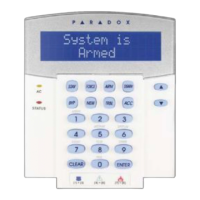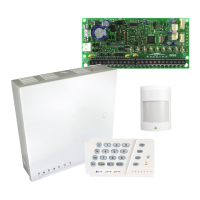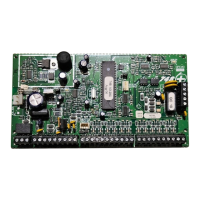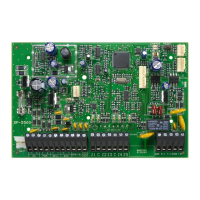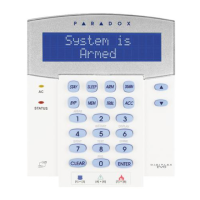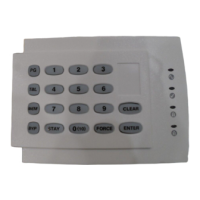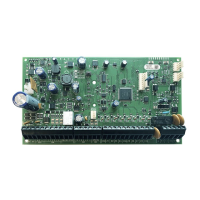
Do you have a question about the Paradox EVOHD+ and is the answer not in the manual?
| Brand | Paradox |
|---|---|
| Model | EVOHD+ |
| Category | Security System |
| Language | English |
Discusses limitations and caveats of alarm systems, including installation and maintenance factors.
Alerts users about potential issues with VoIP connections affecting alarm system functionality.
Mentions the certification body for the product.
Lists the key features and capabilities of the EVOHD+ security and access control system.
Details the technical specifications of the EVOHD+ control panel, including power and dimensions.
Provides a step-by-step guide for installing the EVOHD+ control panel and modules.
Advises on selecting an appropriate site and mounting the control panel for optimal performance.
Explains the procedure for connecting the earth ground for safety and proper operation.
Details the AC power requirements and transformer specifications for the control panel.
Describes how the control panel performs dynamic battery tests under load.
Explains the function of auxiliary power terminals for supplying accessories.
Details the specifications and operation of the bell/siren output.
Describes the function and capabilities of programmable outputs (PGMs).
Explains how to connect keyswitches to the system for arming/disarming.
Lists the physical and environmental specifications for specific keypad models.
Details how to unlock panel serial ports for third-party device communication.
Lists the power consumption of different system devices for calculating total requirements.
Explains connecting detection devices to keypad input terminals for zone assignment.
Describes connecting addressable zone expansion modules to the system.
Details configuring two detection devices per input terminal using ATZ.
Explains connecting modules via the 4-wire Digiplex bus.
Instructions for installing 2-wire smoke detectors using PGM1.
Details the installation of ESL CleanMe smoke detectors.
Instructions for installing 4-wire smoke detectors with relay.
Explains how to connect the system to telephone lines for reporting.
Recommends BabyWare software for system programming and configuration.
Describes copying programming from one module to others via the Digiplex bus.
Details how to program the system using a keypad interface.
Explains assigning serial numbers to zones for addressable devices.
Describes enabling ATZ for two detection devices per input terminal.
Details the parameters for defining zone types and behavior.
Configures entry delay timers for partitions, affecting arming/disarming response.
Defines how zones behave during entry delay, potentially delaying alarms.
Describes zones that trigger immediate alarms when armed.
Explains zones that trigger keypad buzzers on breach without activating siren.
Defines zones that trigger immediate burglary alarms.
Defines zones that trigger immediate hold-up alarms.
Defines zones that trigger immediate gas alarms.
Defines zones that trigger immediate heat alarms.
Defines zones that trigger immediate water alarms.
Defines zones that trigger immediate freeze alarms.
Configures fire zones with a delayed alarm to reduce false alarms.
Configures standard fire zones with immediate alarm reporting.
Defines zones that trigger alarms after a stay delay.
Assigns zones to specific partitions within the system.
Details various configurable options for zone behavior.
Configures automatic shutdown of zones after multiple alarms.
Allows zones to be manually bypassed by users.
Defines zones that are active only during Stay arming.
Defines zones that are active only during Force arming.
Configures how alarms are reported (Steady, Pulsed, Silent, Report Only).
Enables advanced zone alarm logic for smarter detection.
Sets the response time for hardwired input terminals.
Configures End-Of-Line (EOL) resistors for hardwired zone connections.
Allows selection of different EOL resistor values for zones.
Assigns unique numbers to keypads for event logging and identification.
Sets up templates for remote control button functions and assignments.
Assigns system inputs to keyswitch zones for control.
Defines the function of keyswitches (disabled, momentary, maintained).
Allows partitions to follow the arming status of other specified partitions.
Controls whether troubles remain displayed after correction.
Lists conditions that prevent arming (supervision loss, tamper, AC/battery failure, etc.).
Configures automatic arming if no movement is detected within a partition.
Selects arming method (Force or Stay) for auto-arming partitions.
Allows switching from Regular to Stay arming based on entry delay activity.
Forces arming during Regular arming, regardless of zone status.
Forces arming during Stay arming, regardless of zone status.
Links zone bypasses to trigger the partition's Entry Delay 2.
Enables one-touch arming/disarming and other functions via keypad.
Configures the time to leave the premises before arming.
Locks out keypads after multiple invalid code entries.
Configures brief bell activation for alerts during arming/disarming or delays.
Configures keypad beeps or bell squawks after disarming for user warning.
Limits the number of zones that can be bypassed per partition.
Controls the display of bypassed zones on armed keypads.
Controls the main bell/alarm output for each partition.
Sets the duration for the bell/alarm output after an alarm event.
Configures how often alarms are re-verified by the system.
Manages supervision status for wireless transmitters and their reporting.
Determines if bypass definitions affect supervision status.
Configures a timer for generating police codes on specific alarm conditions.
Sets how tampers and wire faults are recognized and reported.
Determines if bypass definitions are ignored for tamper/wire faults.
Configures panic alarm activation via keypad combinations.
Controls whether report codes are transmitted to the monitoring station.
Details setup for IP/PCS/GPRS reporting modules.
Explains report code formats and values for various event types.
Configures report codes for zone alarms and restores.
Configures report codes for tamper events and their restoration.
Configures report codes for keyswitch arming events.
Configures report codes for keyswitch disarming events.
Configures report codes for access code arming events.
Configures report codes for access code disarming events.
Lists report codes for various system events like cold start or installer login.
Lists report codes for special disarming features like cancel auto-arm.
Lists report codes for special alarm events like emergency panic.
Lists codes indicating system troubles like AC failure or battery failure.
Lists codes indicating the restoration of system troubles.
Defines schedules for partition arming and disarming, including days and times.
Adjusts schedule timing with a tolerance window for user access.
Configures up to four monitoring station phone numbers for reporting.
Sets the account number for system event identification.
Selects the communication format (e.g., Ademco, SIA) for reporting.
Details standard pulse reporting formats like Ademco slow and Sescoa.
Explains the high-speed Ademco Express reporting format.
Explains the fast Ademco Contact ID reporting format using tone reporting.
Explains the fast SIA FSK reporting format using tone reporting.
Assigns event groups to specific telephone numbers for reporting.
Sets the delay for reporting recent close events.
Configures the delay for transmitting power failure report codes.
Configures automatic system test reports transmission.
Controls when disarm report codes are sent to the monitoring station.
Controls when zone restore report codes are sent to the monitoring station.
Automates the programming of default report codes for Contact ID/SIA formats.
Monitors the status of the telephone line for connectivity.
Sets the timer for detecting telephone line failure.
Selects between tone or pulse dialing format for communication.
Enables detection of busy signals to avoid dialing failures.
Switches dialing to pulse if tone dialing fails.
Activates the bell output upon communication failure.
Configures keypad confirmation beeps for successful reports.
Sets the delay for dial tone detection before dialing.
Provides instructions for installing the VDMP3 voice module.
Explains activating PGMs using VDMP3 features and utility keys.
Details the programming of programmable outputs (PGMs) for various functions.
Configures events that trigger PGM deactivation.
Sets the base time unit for PGMs (seconds or minutes).
Allows overriding PGM events for testing purposes.
Assigns the keypad to a specific partition for operation.
Controls whether access codes are displayed or masked on the keypad.
Controls whether the exit delay timer is displayed on the keypad.
Resets sections to default values via hardware button.
Resets specific sections to default values via software commands.
Prevents hardware resets from altering current panel settings.
Enables automatic adjustment of the system clock for daylight saving time.
Selects the schedule for daylight saving time adjustments based on region.
Configures the speed of the Digiplex bus for optimal communication.
Enables transmission of zone status information via the serial port.
Explains the system's ability to support multiple independent partitions.
Assigns system events to specific partitions for reporting.
Disables display and LEDs during Shabbat period to maintain privacy.
Sets and manages the installer's access code for system configuration.
Configures the length of user access codes (4 or 6 digits).
Sets the master code for system-wide programming and control.
Details the process of programming user access codes and their options.
Defines user access code permissions and capabilities for arming/disarming.
Defines key terms used in access control systems like Access Alarm and Access Card.
Lists the minimum steps required to program access control functionality.
Activates the access control functionality on the system.
Assigns modules or keypads to specific doors for control.
Defines which doors users can access based on assigned levels.
Sets the times and days doors are accessible to users.
Configures how doors are accessed (OR/AND logic) and user permissions.
Enables access via code entry instead of or with an access card.
Requires both a valid card and code for access to a door.
Allows arming without exit delay when using an access card.
Prevents arming via access card if the door is assigned to the partition.
Prevents disarming via access card if the door is assigned to the partition.
Triggers a burglar alarm for forced or left-open doors.
Records access control events in the event buffer for review.
Records REX events in the event buffer.
Records Door Left Open Restore events in the event buffer.
Records Door Forced Open Restore events in the event buffer.
Lists automatic report codes for system events and their corresponding values.
Provides a list of Contact ID report codes and their hexadecimal values.
General instructions for installing EVOHD+ keypads.
Details how to connect keypads to the Digiplex bus.
Explains connecting detection devices to keypad input terminals.
Specific connection diagram for K641R keypad access control.
Compliance information regarding FCC regulations for the equipment.
Compliance information regarding CTR-21 regulations for telecommunication connections.
General safety precautions for installation and maintenance personnel.
Information regarding the product warranty terms and conditions.
